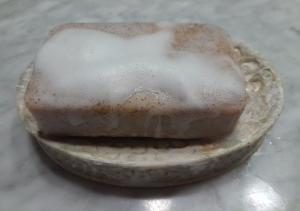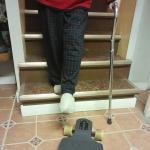
This small room can potentially be one of the most dangerous. We are of course talking about the bathroom.
Here we will discuss how to make it a little safer by lowering the fall risk.
Even a small slip can have devastating consequences. So when it comes to safety in the bathroom, one of the most important considerations is the floor surface.
A non-slip surface can mean the difference between a safe and enjoyable shower experience, or a dangerous fall and trip to the emergency room.
In this article, we will look at the ways to improve the surface of bathroom floors to make them safer for all and especially for seniors.
We will also consider a few other safety measures to further protect your loved ones. So let’s dive in!
Why Falls Occur in Bathrooms
It is not hard to believe that of the falls that occur around the home many of them happen in bathrooms. Here are a few reasons why that is true.
The two main reasons are the presence of water and soap residue on the floor.
When taking a shower, the shower floor soon builds up with soap suds making it a very slippery surface. That’s the first area of concern and an issue that needs to be addressed.
It’s probably something that you’ve never contemplated but excessive and unnecessary foot movements can make a fall more likely as well.
Your feet move, pivot and step, reaching for shampoo or positioning the body for a better rinse. This can lead to falls when wet feet lose their grip on a wet and soapy floor.
Another contributor to bathroom falls is the flooring type itself. Some flooring types are of course more slippery than others, especially if yours is made of high-gloss ceramic or glass tiles.
Another fall risk for seniors is when a walker is required but not used because the available walker is too wide for a smaller bathroom. That situation is certainly a recipe for falls.
Another culprit that causes bathroom falls is a thick throw rug. They look nice but can catch a toe and can cause a fall. Keeping the floor surface unobstructed can make the bathroom a much safer place indeed.
The absence of shower grab bars can make a bathroom more dangerous as well for seniors. Placing them around showers, and toilets is a smart fall-prevention measure.
In summary, here is a listing of some of the contributors to bathroom falls:
- Wet floors
- Soap residue build-up
- Unnecessary foot shuffling
- Flooring type
- Lack of mobility device in narrow bathroom
- Rug obstacles and trip hazards
- Lack of shower grab bars
Further reading: “Senior Fall Prevention Tips”

Fall Risk Reduction Tips
So we have identified some of the major causes of bathroom falls and now in this section, we will address each one.
Wet floors
Keep mops and towels handy to promptly remove water drips and spills. If there is a caretaker to help out make sure it is on their list or brought to their attention.
Soap Residue Build-up
Regularly cleaning your shower floor can help to reduce the risk of slips and falls, as dirt, soap residue, and grime can make the floor more slippery. Make sure to use a mild cleaner that is specifically designed for use on tile and other bathroom surfaces, and use a soft-bristled brush to scrub away any dirt and debris.
The same proactive approach should be taken here making sure that scrub brushes and other needed supplies are always available.
Bring this as well to the attention of any caretakers and household helpers so that they can assist you in this important task.
Unnecessary Foot Shuffling
You may think to yourself that no improvements can be made here. After all, you hardly ever shower to “You Ain’t Nothin but a Hound Dog”! Well, I said “hardly”!
Any improvements no matter how small do make a difference. So how can this unnecessary movement be minimized? Step back and analyze the bathroom and shower area layout.
First, go through everything and toss out anything that is no longer needed. That alone can help to make needed items easier to find.
Also, excessive clutter can make dropping things onto the floor more likely, and bending over can cause a tumble.
Frequently used items should be stored in easy-to-reach places. They should be at eye or shoulder level to make it easy to grab without bending over or overreaching.
Another way to cut down on excessive movement in the shower is to install a handheld shower wand. That is a convenient way to direct the water spray where you need it
without turning your body or shuffling your feet.
Look around and make any other changes that can save you steps and so lower the chances of falling in the bathroom. Then you can “Twist and Shout” but even then,
make sure that your feet are dry!
Flooring Type
As we mentioned, high-gloss ceramic or glass tiles are especially slippery when wet. If you ever do bathroom remodeling sometime in the future keep this in mind and
ask the floor materials dealer for slip-resistant bathroom flooring choices.
What if you want to ensure a firmer footing grip but don’t want to spend the inheritance on replacing the floor? Here are a few ideas.
Non Slip Shower Mat
These mats are designed specifically to provide traction and grip on slippery surfaces, and they should be placed in areas of the shower that are prone to becoming slippery.
You can find these mats in a variety of sizes, materials, and colors, so they can fit in with any bathroom decor.
Non-Slip Stickers
These are stickers that can be placed on the shower floor to increase traction and prevent slips. These strips are made from a variety of materials, such as rubber,
vinyl, and silicone, and are designed to provide extra grip on slippery surfaces. They are easy to install and can be purchased in a variety of sizes, shapes, and colors to match your decor.
Non-Slip Coating
This type of surface is created by applying a special coating to the surface of the shower. The coating is designed to provide extra grip and prevent slips.
There are different kinds with some being clear and others are like paint. These treatments can be either brushed, rolled, or sprayed on to create a safer bathroom surface.
Some of the pros to using a coating treatment:
- Easy-to-apply
- No more peeling shower floor stickers
- No need to clean a moldy shower mat
Lack of mobility device in narrow bathroom
If you use a walker but find it difficult to maneuver in your narrow bathroom you may need to consider a narrow walker.
Rug Obstacles and Trip Hazards
Throw rugs may look nice but are more of a trip hazard in the bathroom. Remove anything that can snag a toe and become a tripping hazard.
Also, be careful of the placement of magazine racks and trash bins keeping them away from the walkway in the bathroom.
Lack of Shower Grab Bars
If you need extra stability, installing grab bars in the bathroom is a great solution. Shower grab bars should be installed in and around the shower and around the toilet.
Here are a couple of videos with good information on this subject.
How to Select a Grab Bar for your Bathroom, Shower, or Toilet | Standard vs. Designer
[su_youtube url=”https://youtu.be/Yk8D2M67BGw” responsive=”yes” autoplay=”no”]
How to Decide Grab Bar Placement | Shower and Toilet
[su_youtube url=”https://youtu.be/wED1l1Vilho” responsive=”yes” autoplay=”no”]
It’s highly recommended to consult with an Occupational Therapist to evaluate your bathroom for your specific needs and bathroom configuration.
Use Shower Chairs
Shower chairs make it much safer for seniors to take a shower.
How shower chairs can help to prevent falls and slips in the shower:
1. Sitting reduces foot movement and shuffling.
2. It reduces knee, back, and ankle strain which saves your muscles for balance and movement.
3. Provides a secure and safe place to rest during a shower, reducing overall fatigue.
Proper Maintenance of Non-Slip Surfaces
No matter what type of non-slip surface you choose, it is important to properly maintain it in order to ensure maximum safety.
This includes regularly cleaning the surface to remove any mold, mildew, dirt, grime, or soap scum that may have built up.
Conclusion
The importance of bathroom safety can never be overstated. By taking a few simple steps your bathroom can become a whole lot safer and decrease the likelihood of falls.
FAQ
To maintain a non-slip bathroom floor, you should regularly clean, removing any soap residue. Also, inspect it, and re-apply the non-slip solution as needed.
You should clean your shower floor regularly to reduce the risk of slips and falls. Use a mild cleaner that is specifically designed for use on tile and other bathroom surfaces. Make sure that it says that it removes soap residue.
The different types of non-slip solutions for bathrooms are non-slip mats, adhesive strips, tiles, and paint.
The most common causes of slippery floors in the bathroom are wet tiles, condensation, and soap residue.
You should use non-slip mats that are specifically designed for use in the bathroom. These mats come in a variety of sizes, materials, and colors, so you can find one that fits in with your bathroom decor.
Non-slip strips come in a variety of materials, such as rubber, vinyl, and silicone. Make sure to choose one that is easy to install and fits in with the color of your tile.
To email this article link to a loved one or friend please click on the envelope!



